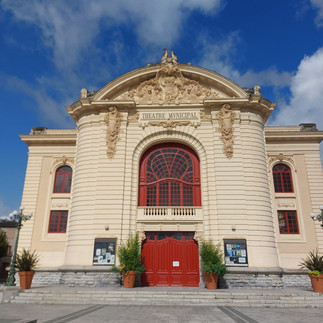At 6:30 a.m., I was having breakfast with the other pilgrim, Rémi from Fontainebleau, in the Gîte Municipal. He is an IT professional who has taken a few months off to walk from Arles to Santiago. He first traveled by train to Arles, and now he walks 20 to 30 kilometers a day until he reaches his destination. He doesn't talk about his motivation, and that's fine. After a brief farewell, I set off on my bike towards Castres. It was a drizzly, gray, and wet morning that only got wetter as it started raining harder. I stopped, put on my poncho raincoat, and continued cycling. Slightly downhill and then uphill through dark forests where you can hardly see the trees. Apparently, I am all alone on this unpleasant morning, cycling along a large lake. My mood is also gloomy, and I lack the motivation to continue, but I have no choice.
Cycling in the rain ion a dark and Fcloudy morning
After at least an hour’s ride through the dark, hostile forests, I reached the village of Anglès. As is common throughout Occitanie, farmers had flipped the town's name sign upside down in protest. It’s a stop for every pilgrim on the way to Santiago, but the church and village have little to offer. The old Romanesque church was destroyed during the religious wars of the 16th century and has been rebuilt several times since, but it’s not particularly attractive. The church is closed, and everything is wet and gray. So I kept cycling through Bressac towards Castres. I saw the sky break open and the landscape change simultaneously. The dark, threatening forests were replaced by rolling hills with the yellow of dried straw, the green of corn, and dried sunflowers. Past Bressac, I left the Parc Régional du Haut Languédoc and descended into the valley towards Castres. More than 20 kilometers downhill without needing to pedal.
Anglès
In Castres, the sun came out, and I stopped by the river and then at the square where both the town hall, the Goya Museum, with a beautiful garden behind it, and the cathedral, a 17th-century Baroque building that’s not particularly attractive, are located. The cathedral is dedicated to St. Benedict, which is extremely rare. Nearby is Place Jean Jaurès. Both Jaurès (a minister who reformed the republican education system) and Goya (a painter who dared to criticize the state through his art) were born in Castres and deserve much attention.
Castres
Place Jean Jaurès has a beautiful fountain. I was about to leave the square in front of the cathedral when a couple with three children arrived and opened the church door: the sexton and his family, as there was a mass at 10:30 AM. His kind wife immediately told me I could get a special stamp as a pilgrim. So, I must have looked like a pilgrim, a bit disheveled and not very fresh. The children were already busy setting the altar cloths while the sexton took me to the sacristy for the stamp.
Next to the Goya Museum is a beautifully restored theater that I could photograph in the bright sun.
Castres: cathedral, Musée Goya and theater
I took a few more photos and left the city, heading towards Mazamet and then later towards Revel. On the way, I passed through the village of Viviers-les-Grandes-Montagnes, where there used to be a Benedictine priory with fish ponds (Viviers) where fish were raised. A small castle, the church, and some old houses form a picturesque ensemble. I continued cycling and reached Revel, near Lake St. Féréol, at 1 PM. Revel has a beautiful village square in the shape of a bastide, with houses featuring covered walkways, and in the middle, a stunning barn with an impressive wooden framework. Under this structure, I ate my sandwich with the leftovers from yesterday: cheese and garlic sausage with a bit of mayo.
Viviers-les-Montagnes and Revel
After lunch, I had 30 more kilometers to go to Avignonet-Lauragais, right next to the Canal du Midi. The canal is fed by Lake St. Féréol and several reservoirs and channels (rigoles) that bring water down from the Montagne Noire. Nearby are beautiful roads lined with plane trees, which I had to photograph because they are particularly beautiful.
I made a brief stop at the church of Avignonet, which is remarkably slender and impressive. I quickly slipped inside the church and then went to find my Pilgrims' Gîte. I found out that it was still 6 kilometers away and atop a super steep hill. To get there, I had to cross the canal at Port Lauragais. The last time I was here, we were together with brothers-in-law and sisters-in-law, and Uncle Eric was our excellent freshwater captain on the canal: it was a great time.
The church of Avignonet-Lauragais, the gîte and the Canal du Midi
I reached the Pilgrims' Gîte of Danielle around 4 PM, a beautifully restored old house, not large but nicely done, with two rooms that can accommodate six pilgrims. I was alone and had requested half-board. Peter and his girlfriend had offered to come over from Serviès-en-Val (120 km away). I asked Danielle if she could cook for all of us for a fee, and she was happy to do so: a delicious tomato salad, then ratatouille with Toulouse sausage, accompanied by a fresh rosé, and Greek yogurt for dessert. A wonderful meal with a pleasant conversation with the hostess. That’s the tradition in pilgrim houses: the cook eats at the table with the guests. Afterward, Kim and Peter left, and I wrote my blog and then went to bed because tomorrow I have to cycle past Toulouse to L'Isle-Jourdain, heading towards Oloron-Ste-Marie and Spain. It was another fine and busy day with a gloomy beginning and a sunny end in every way. Now to call Magda…
Yves en Kim voor de gîte, het uitzicht vanuit de gîte en Kim tussen de zonnebloemen











































Comments